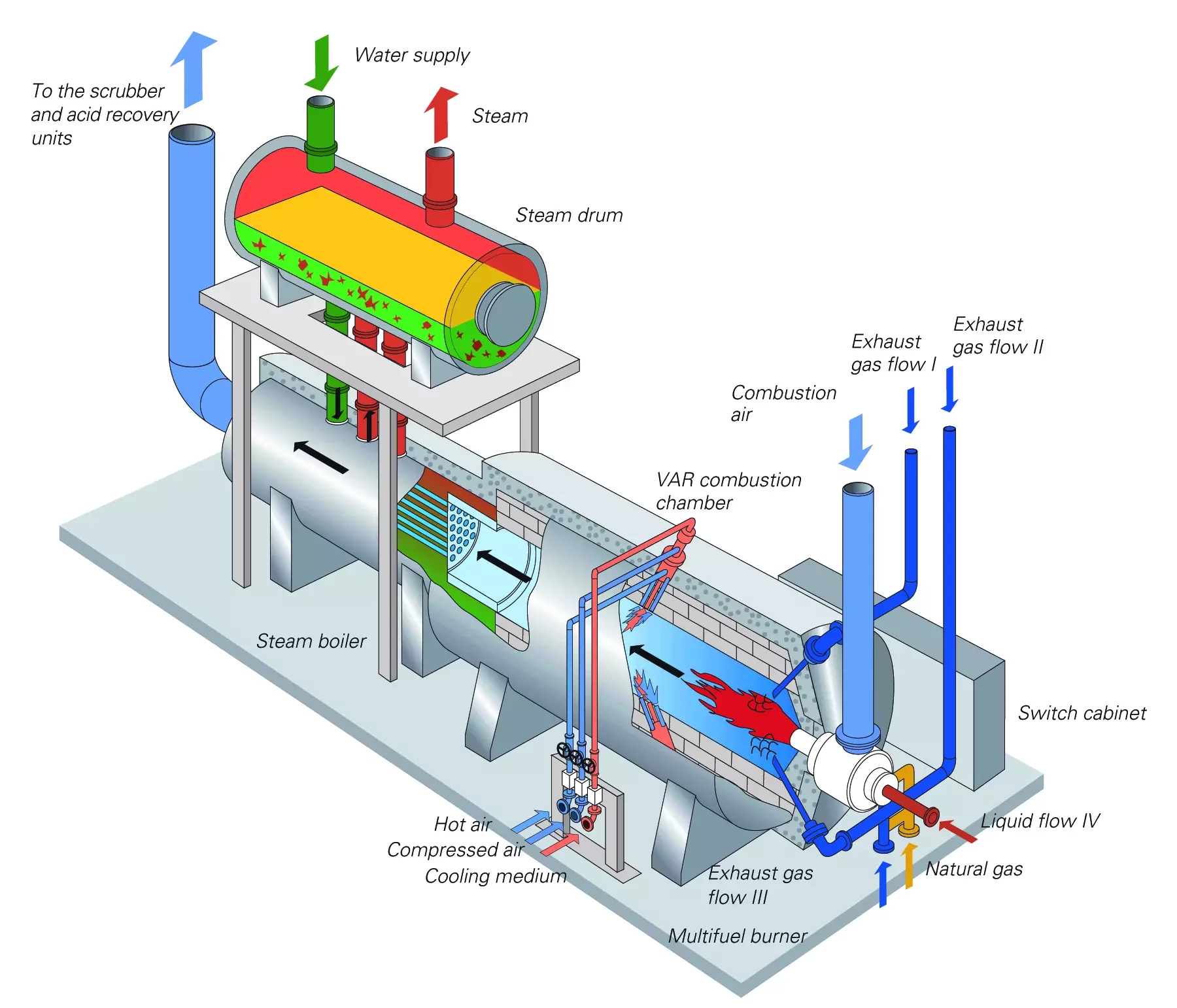A technology that has been installed by Dürr already in the early days of carbon fibre production in 1988 and that is still in permanent operation is the Ecopure® VAR technology, a direct fired thermal oxidiser system.
A VAR system consists of a refractory lined oxidation chamber, a burner unit and injection nozzles and lances, through which the exhaust gas from the carbon fibre oxidation ovens and carbonisation furnaces is directly injected into the oxidation chamber. By a turbulent mixing of these gases and heating them up to high temperatures with the burner, more than 99.9 % of these pollutants are destroyed and oxidised into harmless water and CO2 vapours. The hot purified gas leaving the oxidation chamber can then be used for the production of steam or for the heat up of thermal oil, hot water or fresh air that can be used as energy source for the ovens and furnaces.
Based on these early experiences Dürr has developed and installed in the 1990ies a special burner system and a special way how to inject the various exhaust gases such that the 99.9 % destruction and all the relevant emission limits in Europe, The United States and Asia are already achieved at oxidation temperatures around 850 – 900°C, whereas usual systems still today require temperatures of more than 1,100°C to achieve these limits. Even the formation of NOx is reduced to a minimum in the Ecopure® VAR and the NOx concentration in the purified gas stays below 20 ppm.
With such a burner technology the Ecopure® VAR systems made by Dürr provide the carbon fibre manufacturers a huge saving on the fuel require-ment for their exhaust gas treatment and significantly lower operating costs.
Dürr provides Ecopure® VAR systems treating the exhaust gases from the oxidation ovens and carbonisation furnaces in one combined unit as well as systems just for the treatment of the exhaust from the carbonisation furnaces.
Depending on the type of carbon fibre and prematerial sometimes also small amounts of silicone substances are released with the oven and furnace exhaust gas. These silicone substances oxidise into a solid that can block the heat recovery system if not properly considered in the design. For this reason Dürr also provides special designed heat recovery systems to overcome such a blockage or with automatic cleaning during plant operation.
As such, many carbon fibre producers are cleaning their exhaust air with a Dürr Ecopure® VAR unit and recover their heat energy for the process, such that the temperature of the purified air being finally discharged to atmosphere is lower than the temperature of the incoming exhaust gases. The result and bargain for the carbon fibre producer is not just a green and environmental friendly process, but also an energy requirement that is lower as it would be without exhaust gas treatment.
For all carbon fibre producers who cannot make use of all the possible recovered heat, Dürr offers the possibility to treat the exhaust gas from the oxidation ovens or a part of it in a Regenerative Thermal Oxidiser Ecopure® RTO, a technology that Dürr has installed already in 1996 for some carbon fibre makers.
An Ecopure® RTO plant consists of its refractory lined regeneration heat exchanger tanks, oxidation chambers and associated burner system as well as a duct system for direction of air streams.
Each regeneration tank is packed with ceramic heat exchange material. The oxidation chambers include the burners and link the individual regeneration tanks to each other.
Tightly sealing, time controlled valves are integrated within the duct system for letting in exhaust gas and taking out purified gas, as required, to one of the regeneration tanks. The exhaust gas flows through the ceramic material from bottom to top so that it is preheated. At this stage a large proportion of the pollutants are already oxidised. In the oxidation chamber the exhaust gas is heated up to its full reaction temperature completing the cleaning process. The purified gas then flows through the other tanks from top to bottom transferring its heat to the ceramic material.
Dürr Ecopure® RTOs are convincing because of their tremendously high level of thermal efficiency of up to 97%, such that the temperature of the purified gas leaving the Ecopure® RTO units is just around 30 – 40 °C higher than the temperature of the incoming exhaust gas. Therefore Ecopure® RTO units can be operated autothermal, without any fuel requirement already at low pollutant concentrations in the exhaust gas, due to the thermal heat release during the oxidation process. Dürr Ecopure® RTO units also achieve destruction efficiencies up to 99.9 % and are in compliance with all the relevant emission limits in all countries.
With the combination of Ecopure® VAR for the treatment of the carbonisation furnaces exhaust gas and Ecopure® RTO for the treatment of the oxidation oven exhaust gas the fuel consumption of the exhaust gas treatment system is close to zero, just a pilot flame is required. In addition heat can be recovered from both systems reducing the energy requirement for the production line to a minimum.
With more than 30 exhaust gas treatment systems for carbon fibre pro-cesses in Europe, the United States and Asia and operation experience over 20 years, Dürr is able to provide the best solution for the exhaust gas treatment and energy optimisation of all carbon fibre processes, inde-pendent if new lines will be built or existing lines will be upgraded.
Besides the carbon fibre process Dürr´s Environmental and Energy Systems business unit also provides exhaust gas treatment solutions for carbon fibre recycling, composites or prepreg fabrication, all chemical and pharmaceutical processes, painting and coating applications or VOC or odour reduction processes where required.


